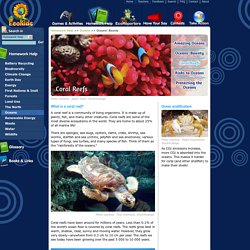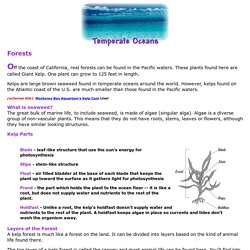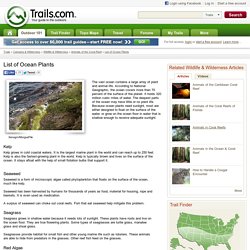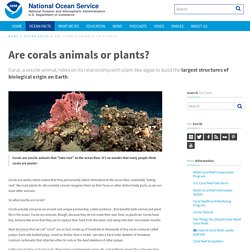

Coral Reefs. What is a coral reef?

A coral reef is a community of living organisms. It is made up of plants, fish, and many other creatures. Coral reefs are some of the most diverse ecosystems in the world. They are home to about 25% of all marine life! There are sponges, sea slugs, oysters, clams, crabs, shrimp, sea worms, starfish and sea urchins, jellyfish and sea anemones; various types of fungi, sea turtles, and many species of fish. Photo courtesy: Tony Hathcock, StockXchange. Coral reefs have been around for millions of years. Photo courtesy: Adam Short, StockXchange. Coral reefs are made of tiny animals called “polyps” that stay fixed in one place and are the main structure of a reef. Each polyp is connected by living tissue to form a community. Each polyp has a ring of tentacles shaped like a cup around a central opening. Stunning Underwater Plants and Sea Life on the Ocean Floor.
The ocean is full of uncharted territory -- and of breathtaking natural wonders that look like they'd be more at home on Pandora than in the blue depths just off the beach where you spent your summer vacation.

These stunning underwater organisms offer an ethereal beauty hard to reproduce on land. The vibrant hue of this lilac-looking purple coral isn't the only striking thing about it: Though the color is rare, this acropora coral is probably one of the most popular among sealife -- according to Animal World, acropora and monitor corals together comprise nearly 1/3 of reef-building species, which means they're often the first on the scene of a new reef, and they spread to provide homes for other corals. Photo via mattk1979 @ Flickr. Permian Period: Climate, Animals & Plants.
The Permian Period was the final period of the Paleozoic Era.

Lasting from 299 million to 251 million years ago, it followed the Carboniferous Period and preceded the Triassic Period. By the early Permian, the two great continents of the Paleozoic, Gondwana and Euramerica, had collided to form the supercontinent Pangaea. Pangaea was shaped like a thickened letter “C.” The top curve of the “C” consisted of landmasses that would later become modern Europe and Asia. North and South America formed the curved back of the “C” with Africa inside the curve. Marine life Little is known about the huge Panthalassic Ocean, as there is little exposed fossil evidence available.
Ocean Forests. Forests Off the coast of California, real forests can be found in the Pacific waters.

These plants found here are called Giant Kelp. One plant can grow to 125 feet in length. Coral reef. Coral reefs are underwater structures made from calcium carbonate secreted by corals. Coral reefs are colonies of tiny animals found in marine waters that contain few nutrients. Most coral reefs are built from stony corals, which in turn consist of polyps that cluster in groups. The polyps belong to a group of animals known as Cnidaria, which also includes sea anemones and jellyfish. Unlike sea anemones, coral polyps secrete hard carbonate exoskeletons which support and protect their bodies. Reefs grow best in warm, shallow, clear, sunny and agitated waters. List of Ocean Plants. Kelp Kelp grows in cold coastal waters.

It is the largest marine plant in the world and can reach up to 250 feet. Kelp is also the fastest-growing plant in the world. Kelp is typically brown and lives on the surface of the ocean. It stays afloat with the help of small flotation bulbs that support it. Seaweed Seaweed is a form of microscopic algae called phytoplankton that floats on the surface of the ocean, much like kelp.
Seaweed has been harvested by humans for thousands of years as food, material for housing, rope and baskets. A surplus of seaweed can choke out coral reefs. Seagrass Seagrass grows in shallow water because it needs lots of sunlight. Seagrasses provide habitat for small fish and other young marine life such as lobsters. Red Algae Red algae grows in warm tropical water.
Coralline Algae Coralline algae consists of very fine filaments that grow over rocks. Coral and Algae Coral is not a plant; it is an animal organism. Why are aquatic plants so important? Are corals animals or plants? Corals are sessile, which means that they permanently attach themselves to the ocean floor, essentially "taking root" like most plants do.

We certainly cannot recognize them by their faces or other distinct body parts, as we can most other animals. So what exactly are corals? Corals actually comprise an ancient and unique partnership, called symbiosis, that benefits both animal and plant life in the ocean. Corals are animals, though, because they do not make their own food, as plants do. Corals have tiny, tentacle-like arms that they use to capture their food from the water and sweep into their inscrutable mouths.